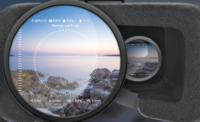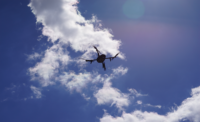On April 11 and 12, several bomb-laden drones targeting oil refineries and military air bases in Saudi Arabia were shot down by Saudi military forces. A Yemeni Houthi militia claimed responsibility for the attacks, only the latest in a series of strikes on Saudi targets using relatively low-cost drones. To thwart similar attacks stateside, the Federal Aviation Administration (FAA) is now testing drone detection and defeat technologies to protect airports and enacting rules for digital drone license plates.
Airports, prisons, nuclear power plants and government facilities are currently jockeying to update their drone security measures. These measures will need to evolve alongside drone technology, says Oleg Vornik, CEO of DroneShield, an unmanned aerial systems (UAS) security firm. “The agility, navigation, autonomy, swarming, AI-based technologies and better power and flight management tech will all make UAS more pervasive and give potential for a greater disruption,” he says.
Some of the means of detecting invading drones are radar, cameras, high-powered microphones and radio frequency detection. But not all options are legal for the private sector, no matter how critical the jobsite, says Alex Morrow, vice president of defense solutions at Dedrone, which sells airspace security products.
“Radio frequency sensors are passive and do not require authorization for use; however, radar, which emits signals, will require FCC permission to use. Jamming, interrupting a drone signal or in any way defeating a drone is illegal and only allowed by certain federal agencies with proper approval,” says Morrow.
Certain methods of detection are legal for private sector use and enable the operator to infer the pilot’s location, offering the chance to apprehend the pilot, says Vornik. He adds that damaging an invading drone is just as illegal as damaging other kinds of private property.
So if a private business detects an incoming drone threat, what can it do in response? “Aside from calling the cops and hoping that they find the operator, you can’t do anything,” explains Zachary Shuman, aviation director at Woolpert, an architecture, engineering and geospatial consultant. This is partly due to the FAA’s designation for drones, he adds.
“Drones are technically aircraft; you’d be hijacking an aircraft if you take it over or shoot it down,” says Shuman. “It’s a serious problem that Congress will look at. We believe the Dept. of Justice may change those laws and the new FAA section 383 will help safely accomplish that.”
Airport Safety and Airspace Hazard Mitigation and Enforcement is the title of section 383 in the FAA’s Reauthorization Act of 2018. Its goal is to vet technology for airports that detect UAS in the national airspace. The FAA hired Woolpert and other contractors and began tests in March at five U.S. airports, an operation that was delayed a year due to COVID-19 and other causes, says Shuman.
The present gap in standards and regulations combined with the difficulty of obtaining radar as a private enterprise can create a security risk. By disabling the radio frequency transmitters on both drone and controller, the UAS is turned what the security industry calls RF-silent dark in a matter of minutes and can evade RF detection, says Spencer Prows, vice president of engineering and customer success at Fortem Technologies, an airspace security firm. “They use GPS waypoints to fly missions in a defined pattern without an operator,” says Prows.
While the FAA only allows federal agencies to use active drone defense systems, these systems are being used to bring down unwanted drones abroad. Fortem Technologies offers a drone that will physically intercept invading UAS. DroneHunter is a large UAS armed with a projectile net that can hunt incoming drones and bag them, literally. The difficulty of piloting such an operation is handled by AI and autonomous flight. DroneHunter uses radar to autonomously seek, find and capture incoming UAS.
“We do not see defeat options happening anytime soon in the U.S.,” says Morrow. “However, as more defeat technology is tested and developed, laws on accessing and using this technology may change.”
Though not authorized to defeat or interrupt flight, prisons and other secure locations use cameras, antennas and microphones to document UAS invasions and work with local law enforcement agencies to apprehend pilots, or use evidence of drone intrusions to report to federal authorities, says Morrow.
“Airports are preparing for UAS interruptions to their operations,” says Thomas Mackie, vice president, Woopert. “They’re very active in trying to flesh out what to do if a detection system sees a drone or if one is reported by a pilot.”
The National Safe Skies Alliance, a nonprofit, hired Woolpert to develop a UAS response guidebook for airports. The guidebook it set to be released in June, and will cover a fairly significant response protocol, says Shuman.
As the FAA tests technology, it doesn’t disclose the names of the products tested, even to contractors like Woolpert, says Mackie. “We’re the unbiased UAS operators,” he says. “Manufacturers names aren’t revealed to maintain testing integrity.”
Though the FAA-selected tech isn’t publicly disclosed, DroneShield and Dedrone secured contracts with federal agencies in the past, making them some likely candidates for testing. But many other companies in the field, such as Aaronia and Robin Radar Systems, also provide drone detection products. “In 2018 to 2020, we saw an explosion of companies entering the space, only to retract or dissolve during the past year—a likely consequence of the economic impacts of COVID-19,” says Dedrone’s Morrow.
DroneShield, which has contracts with the Dept. of Defense and the U.S. Air Force, currently offers a line of mobile, stationary and body-worn devices to detect drones through passive radio frequency detection as well as active radar. According to DroneShield, its stationary antennas and handheld directional antenna guns can interrupt communication between a UAS and its pilot from up to 1.24 miles away.
On April 21, the FAA’s Remote Identification of Unmanned Aircraft Systems rules came into effect after more than a year of review. The ruling states that a remote ID broadcast module aboard the drone must transmit “a unique identifier for the drone; the drone’s latitude, longitude, geometric altitude and velocity; an indication of the latitude, longitude and geometric altitude of control station (standard) or take-off location (broadcast module); a time mark; and emergency status.”
Under the new rules, all drone manufacturers currently selling their products in the U.S. will have to comply with the ruling by Sept. 16, 2022, and all private drone operator in the U.S. must upgrade their aircraft in accordance with the final rule on remote ID by Sept. 16, 2023.
DJI, the largest drone manufacturer, now offers DJI Aeroscope that uses radio frequency detection to locate most DJI-made drones up to 30 miles away. That detection distance outstrips the one- to three-mile range of most RF detection offerings. Aeroscope captures the FAA-required location and velocity data of DJI drones as well as the pilot’s location.
But relying on the FAA’s remote ID rules has its weaknesses, says Vornik. “This will not stop nefarious drone operators, much like registering guns doesn’t stop the illegal use of guns. People will just remove the chips,” he says, adding that defenses against UAS will still be required. “Counter-UAS technologies are also well positioned to track ‘friendly’ drones,” he adds.
FAA Remote ID also includes guidance on drone flights operating beyond visual line of sight and at nighttime, two practices previously not allowed, says Morrow. “We see [this] as just another step forward to the inevitable and accelerating proliferation of drones in our airspace.”







Post a comment to this article
Report Abusive Comment